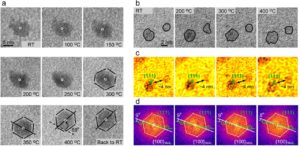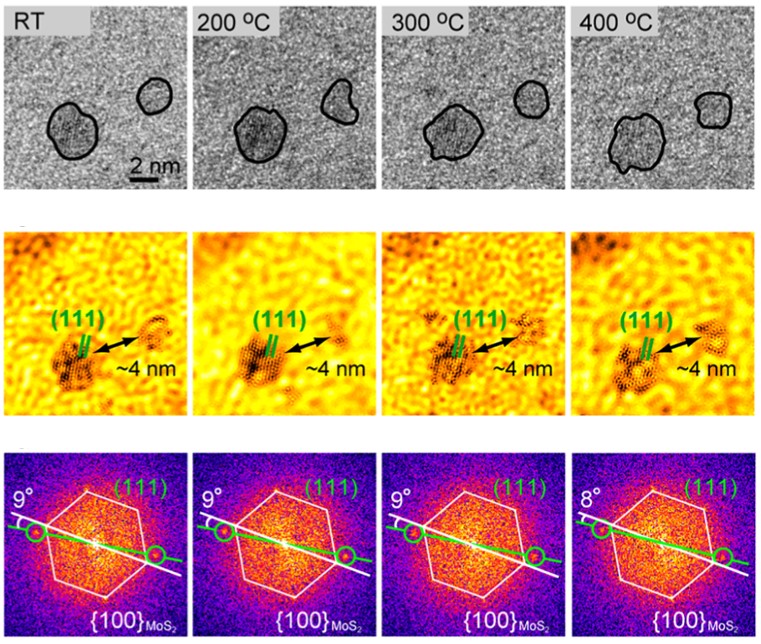Understanding the degradation mechanisms of catalysts during use is critical to improving catalyst durability. Using Hummingbird Scientific’s in-situ TEM gas-heating sample holder, researchers at the University of Illinois at Chicago, the University of Pittsburgh and Argonne National Laboratory have studied sintering behavior of Pt, and Au-core Pt-shell nanoparticles on 2D MoS2 supports at high temperatures under vacuum, nitrogen, hydrogen, and in air environments.
Based on their in-situ TEM observations, they concluded the following:
- Environmental: Particle migration and coalescence was the main mechanism that led to Pt and Au/Pt nanoparticles degradation under vacuum, nitrogen, and hydrogen environments. In air, the degradation of the MoS2 substrate was also present. Pt was less stable in hydrogen when compared with the Pt nanoparticles under vacuum or nitrogen. It is posed that this could be due to Pt−H interactions that weakened the adhesion of Pt to the MoS2 surface.
- Composition: In hydrogen, the stability of Au/Pt was higher in comparison to Pt nanoparticles. It is posed that this is caused by hydrogen promoting alloying of Pt/Au, thus reducing the number of Pt at the surface and increasing the number of Pt atoms in contact with the MoS2 substrate.
- Size: Alloying promoted by the presence of H2 was more pronounced in small size Au/Pt NPs, which resulted in a higher sintering resistance when compared to larger Au/Pt and Pt nanoparticles.
Their work provides vital insights into what affects catalyst degradation mechanisms on 2D catalyst supports. They published their work in ACS Nano.

TEM and HRTEM analysis of Au/Pt NPs on MoS2 during heating in H2. a: TEM image sequence of a 10 nm Au/Pt NP on MoS2 in H2. Black lines outline the NP boundary and hollow circles mark the location of the center of mass. b: HRTEM image sequence of several smaller Au/Pt NPs (≤5 nm) on MoS2 in H2. Two exemplar Au@Pt NPs are outlined with black lines. c: Filtered images corresponding to b. (111)Au/Pt is marked in green and distance between two NPs marked with arrows. (111)Au/Pt is marked in green and distance between two NPs marked with arrows. d: FFT of TEM image sequence in b. Diffraction spots from {100}MoS2 and (111)Au/Pt are shown in white and green. Copyright © 2020 American Chemical Society
Reference: Boao Song, Timothy T. Yang, Yifei Yuan, Soroosh Sharifi-Asl, Meng Cheng, Wissam A. Saidi, Yuzi Liu, and Reza Shahbazian-Yassar, Revealing Sintering Kinetics of MoS2‑Supported Metal Nanocatalysts in Atmospheric Gas Environments via Operando Transmission Electron Microscopy, ACS Nano 2020, 14, 4, 4074-4086 https://pubs.acs.org/doi/10.1021/acsnano.9b08757?ref=pdf
View All News

